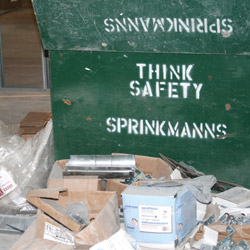
Safety matters, especially to those who work every day on construction jobsites around hazardous materials and situations. The union construction industry, locally and nationally, puts high priority on getting its workers home each night in the same condition they came to work. To that end, the industry takes proactive steps to make safety happen.
Most important to the industry are the rules and regulations established by the Occupational Safety and Health Administration (OSHA) to protect workers at all workplaces. Contractors and trades workers must adhere to these rules or face stiff penalties. Worse, when they do not comply, they risk injury or death. Area contractors, building trades unions and industry associations provide workers with ongoing safety training and certification to ensure compliance with these regulations and safe working conditions for their workers.
In the past several years, OSHA established a partnership program, working closely with business and industry entities to provide quality safety training on a variety of topics and promote safety in the workforce. Union construction trades and associations have entered into these successful partnerships with OSHA.
Most area contractors, in partnership with owners and skilled trades, have a hard and fast rule on construction jobsites—hard hats must be worn at all times. Some sites also require safety glasses, closed-toe shoes, and orange vests for workers, visitors or both. Jobsites will post signage to this effect and close off the hazardous areas with fencing. Most sites also require each worker to have an “OSHA 10-Hour Card,” which means that a worker has participated in a minimum of 10 hours of safety training presented by a certified instructor on various safety topics, like personal protective equipment, fall hazards, electric hazards, and an OSHA overview. Certain topics are required by OSHA, and jobsites may require additional certifications, like First-Aid/CPR, for some workers. Many workers in supervisory roles must have higher-level, more intense safety training and certifications.
Again, training is key to the success of any safety program. Contractors and trade unions, as well as industry associations like Tri-County Construction Labor-Management Council (TRICON) and Greater Peoria Contractors and Suppliers Association (GPCSA), provide ongoing safety training for their employees and members.
Apprenticeship programs for skilled trades include mandatory safety training. Some contractors have full-time safety directors who can provide on-site training for employees and visit jobsites to check for compliance. TRICON, GPCSA, AAIM Employers’ Association, OSHA and others coordinate an annual Downstate Illinois Occupational Safety and Health Day (DIOSHDay.com) that provides training for not only construction, but other industries as well.
Many construction companies and unions offer incentives to their employees or members for good safety records. Many construction companies post signs indicating how many days have passed since a “recordable” injury on their jobsites. If they pass a certain number of days, the company provides an incentive or hosts a celebration. TRICON, as well as individual trade unions and contractors, recognize members of the industry who consistently demonstrate safety on the jobsite through annual safety awards.
Drug testing has become an important issue nationally for the industry. Most apprenticeship programs include mandatory drug testing as part of the application process. Many projects and labor-management contracts include mandatory drug screening provisions.
Getting workers home safely is a priority, but keeping accidents and injuries to a minimum also helps the bottom line. When workers are injured, there are medical and legal costs, and workers’ compensation insurance premiums can escalate. Workers also have lost work time—contractors must scramble to find replacements. The same applies to the health of workers. When workers are unhealthy or ill, insurance premiums go up. Many companies offer incentives and training not only for safety, but for healthy living as well.
When it comes down to it, safety really matters. It matters to the contractors who need to keep costs in check, and it matters to the skilled trades workers who want to keep working in a safe environment. But it matters most to the families and friends to whom workers return each night. iBi

